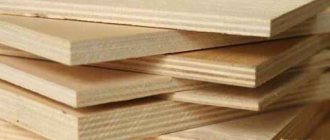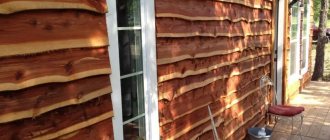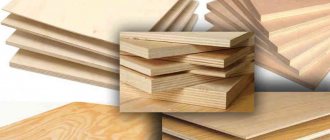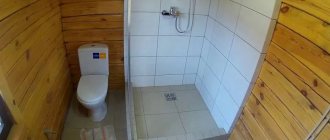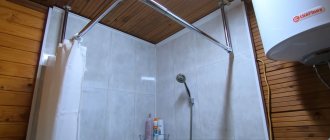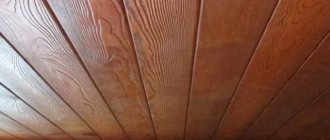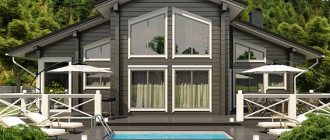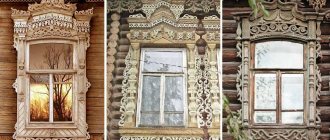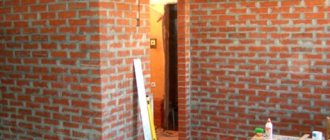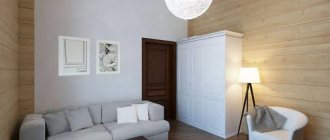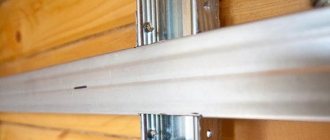Without exaggeration, we can say that this flooring option has been tested for centuries. The technology of laying wooden floors on logs has been used for several centuries with minor changes. This is the most environmentally friendly solution for flooring, but at the same time, this coating has a number of disadvantages and important nuances that you need to know before starting work.
Laying a wooden floor on joists
Features of the floor design on the first floor
The floor on the first floor is of three types:
- cold without underground (on the ground);
- insulated floor with cold underground;
- cold floor with warm subfloor.
Let's look at the features of each design.
A cold floor without an underground is laid as follows:
- First, a sand cushion is built and compacted;
- calcined sand 15 cm thick is poured;
- Logs 15 cm thick are mounted on top. In order for the logs to stand firmly in place, they are buried in the ground and rested against recesses in the walls of the building. The joists must be treated with an antiseptic;
- A single plank floor 25-40 mm thick is laid on the logs. When installing a cold floor on the ground, it is important that the ground is dry.
a) Logs embedded in calcined sand.
b) Logs embedded in a layer of clay and slag.
c) Wooden blocks coated with bitumen on a base of sand, concrete and clay.
An insulated floor with a cold underground is installed on support pillars.
- A layer of sand 10-15 cm thick is laid in the underground and compacted.
- Concrete vertical pillars are poured at the height from the ground level required for constructing the underground. The depth of the supports should be greater than or equal to the depth of soil freezing in your region of residence. The cross-section of the supports is 300 * 300 mm. Reinforcement with a frame, so that the protective layer of concrete is at least 50 mm.
- Waterproofing is placed on the supports in two layers, wooden dies 3 cm thick.
- Logs with slats at the ends are installed on the supports, and a floor made of edged boards is mounted on top. This is a subfloor.
- A vapor barrier and insulation are laid on it.
The finished floor can be made of wood boards, tongue-and-groove boards, or edged planed boards. This type of flooring is installed in a house with a high groundwater level.
It is necessary to provide underground ventilation to prevent rotting of the floors.
A cold floor with a warm subfloor is installed in places with low soil water levels.
This design is similar to the previous one, but instead of a subfloor and insulation, a finished floor is laid. This type of floor is most suitable for southern regions with mild climates.
Wood polymer composite (WPC)
This is the case when wood is mixed with plastic, resulting in an expensive, beautiful, durable and wear-resistant material. WPC is used mainly for constructing floors on open verandas, gazebos, and also for the construction of fences. The cost of WPC is 5-10 times higher than conventional wood boards, so this type of coating is quite expensive, but its service life is several times longer than the service life of wood.
WPC - wood-polymer composite
Types of floors
Your home, built independently, will delight you for decades if you choose the right technology for laying and insulating the floor. A wooden house can have a concrete or plank floor. Sometimes heated floors are installed. The system of such floors differs in the coolant and the degree of efficiency of work.
Concrete floor
Concrete floors are strong and durable. It is equipped with a concrete screed. At the same time, the base of the floor is leveled. Any type of flooring can be laid on a leveled base. The screed gains the required strength in about a month at above-zero temperatures. You can do the concrete screed yourself, without the help of specialists, which will save time and money.
The disadvantages of a concrete floor are:
- heavy weight and high load on the foundation;
- low temperature: it's cold to walk on. To increase its temperature, the floor is insulated. Concrete floors can be installed in two ways: on the ground and on the floors. When the house shrinks, cracks may appear on it.
Wooden floor
environmentally friendly wood coating, does not emit harmful substances;
wood is a warm, natural, breathable material that creates a healthy microclimate in the house;
has a variety of textures;
the material is repairable. If some structural elements are rotten, they can be replaced by dismantling the coating partially, not completely;
the number of tools and equipment for installing a wooden floor is minimal.
high price;
complex and lengthy installation.
Laminate
A modern classic - floors made of laminated boards obtained by pressing waste wood. Fiberboard is the base of the laminate; a pattern and a lamination layer are glued onto it. The larger the lamination layer, the more durable the coating.
The cheapest laminates have a short service life and if you lay it in walk-through areas, in the hallway or living room, after a couple of years you will notice any chips and abrasions of the coating, so you shouldn’t take the cheapest types of it, or lay it in non-passage areas places, so it will last for at least several years and will not lose its appearance.
Inexpensive laminate flooring in walk-through areas quickly deteriorates
The service life of laminates of more or less average price is about 5-15 years.
Laminate flooring is relatively easy to install; after watching a dozen instructional videos and locking up a few sheets due to inexperience, you can lay out a room, and then an apartment, yourself.
The peculiarity of laminate is the speed of installation. A special locking system allows you to lay sheet after sheet in a matter of seconds. This connection is quite strong if the technology is followed.
In appearance, laminate imitates natural wood covering and imitates it quite successfully.
What is better to make from: wood or concrete?
To determine which flooring material to choose: wood or concrete, let’s compare them.
Price
The price of wood is much higher than concrete. Concrete is a mixture of sand, gravel and cement. A bag of cement costs 500 rubles. A screed 5 cm thick requires half a bag of cement: 250 rubles.
A bag of sand and gravel mixture costs 100 rubles. To create a concrete solution you need one and a half bags: 150 rubles. Total 400 rubles. If specialists perform the screed, they add 300 rubles/m2 for the work.
The total cost of a non-reinforced screed is 700 RUR/m2.
If you are laying wooden floors that are not insulated, then dry timber with a cross section of 100*150 mm for joists will cost on average 400 rubles/m2. Inch tongue and groove board - 700 RUR/m2. Payment for work—400 rub/m2.
The total cost of wooden floors is 1500 RUR/m2.
These prices are indicative and are as of 2021.
Deadlines
The screed gains strength in 28-30 days. So that cracks do not form on it and it dries evenly, it is covered with film and periodically sprayed. You cannot walk on the screed for three days. Wooden floors can be used to place furniture on and move around on the day of installation.
Engineering Communication
Typically, utilities: water supply, sewerage, heating pipes are located under the floor. In case an old wooden house needs to be repaired or after an accident, wooden floors can be partially disassembled, sawn and easily removed. After eliminating the emergency condition, individual parts can be replaced. With a concrete floor the situation is more complicated. The dismantling process is complex and time-consuming. You will have to use professional equipment and tools.
Durability
Concrete floors last much longer than wood floors. The quality of the coating can be judged after it has hardened. If wooden floors are laid from raw boards, then after a while you can hear a squeak. The floors need to be disassembled and screwed back together.
Wooden floors on poles (supports)
Wooden floors on supports are installed in a certain sequence:
- markings are made;
- the plant layer is removed from the soil;
- the soil in the pit is removed at least half a meter deep;
- crushed stone is laid;
- a layer of sand is poured onto it, which is moistened and compacted;
- install brick supports. The width of the pillars is 1.5-2 bricks;
- 2 layers of roofing material and wooden stands are laid on top of the supports. The pads are fixed;
- Logs made of coniferous timber are installed on the linings. Before use, they are treated with antiseptic agents;
- so that during frost and thaw there is no movement, the slag is filled in. It does not reach the log by 5 cm. The resulting space ensures ventilation of the structure;
- boards are placed on the logs and driven in with long nails at an angle of 45 degrees. The gap between the walls and boards is 1.5 cm. It is necessary to compensate for expansion. They are covered with baseboards.
The supports can be poured from concrete, as described above. Sometimes, instead of formwork, asbestos-cement pipes or ventilation ducts of round or rectangular cross-section are used.
When installing pillars, it is important to pay attention to the top level. It must be leveled horizontally and vertically using a level or laser level. The distance between supports is 1m.
Useful tips
- Laying a floor on joists or covering a floor without proper experience can take a whole day. While working, knee pads will be very useful.
- The floor should be laid only after finishing the plastering and painting work. Thus, it will not have to be processed again after the repair is completed.
- The strength of the floor will be increased by laying cross beams between the joists (every 2 meters).
- It is better to sand wood with a special sander.
- Varnish or paint will significantly increase the service life of the coating. It will not be superfluous to prime the surface before painting.
- Copper and brass nails do not rust.
- A wooden floor can be an excellent base for laying laminate carpet and other coverings.
Floors on joists
The installation of a floor in a wooden house on joists is identical to the installation of a subfloor. There are differences in the methods of attaching the joists. They are fixed to the base and grillage. They are located at a distance of 2 cm from the walls.
First they make the strapping. The logs are attached to it with anchors, but not rigidly, but only slightly fixed so that they do not wobble. The step between the lags is 40-60 cm.
Skull bars are attached to the bottom edge of the joists. Boards are laid loosely on the bars.
Polyethylene film serves as waterproofing. The joints are fixed with a stapler. The film goes onto the wall.
Insulation is laid over the waterproofing.
The vapor barrier membrane is installed in the same way as waterproofing. A counter-batten is nailed onto the vapor barrier layer. It creates a ventilation gap. You can lay sheets of chipboard or boards on the logs.
By the way, such floors can be insulated from below.
Single layer floor
Single-layer flooring is laid in two versions:
- on brick supports. Beams are placed on them, and flooring in the form of boards or sheet materials is laid on top;
- along the beams. Brick supports are not used. The beams are embedded in the walls. The distance between them is large: about a meter. Therefore, the flooring is attached to the sheathing. The sheathing is made from square timber. It is fixed with nails. It is necessary to ensure its horizontal position so that the coating laid on the logs is even. If you plan to install only boards, and the finishing coating: laminate, linoleum will not be laid, then the boardwalk is considered finished. At the end of the work, the floor is varnished.
Double floor
A double floor consists of a rough and a finishing coating.
Skull bars are nailed to the bottom of the installed logs. Boards are placed tightly between the skull blocks.
Moisture-proof material is laid on the boards. Then the insulation and vapor barrier membrane are laid. Tongue and groove boards of the finished floor are laid on it. To ensure that the space between the finished and subfloor is ventilated, vents are made in the corners of the finished floor and covered with decorative grilles.
Materials for processing logs
In order for logs to be used for a long time, it is important to protect them from harmful environmental influences: precipitation, wind, dampness. Therefore, before installation they are treated with various means.
Bioprotective compounds
Bioprotective compounds protect wood from fungus, mold, and insects. The protection period is from 25 to 30 years. Concentrates are used. Sometimes pigment is added to them, with which you can ensure uniform application of the product. Bioprotective products are environmentally friendly, do not emit toxic substances, and are hypoallergenic. The smell is slightly perceptible. They are applied before installing the floor.
Leave-in antiseptic
A non-washable antiseptic is necessary to protect against high humidity and temperature changes. Product consumption: 400 g per 1 m. To achieve a certain result, it is important to apply up to 4 layers of the product. Neomid works well.
Folk remedies
Folk remedies include:
- transformer oil. It penetrates deep into the pores of the material and protects it from pathogenic microorganisms;
- resin Birch resin protects against fungus, mold, rot and bugs. but does not protect against fire;
- used motor oil. It has good protection against insects and bacteria. Its cost is low, but a significant disadvantage is the strong odor that does not disappear for several months.
Installation of subfloor
The subfloor is a flat surface, without dips and depressions, on which the finishing coating is laid.
The subfloor performs a number of functions:
- holds insulation;
- distributes the load evenly;
- hides communications, insulating material;
- reduces noise levels between floors;
- reduces heat loss in the room;
- is the basis for finishing coating.
May be interesting: TOP 8 remedies for getting rid of bark beetle
For the subfloor, unedged boards, plywood, OSB, and gypsum fiber board are used. To ensure a reliable base, the subfloor is made in two layers. It is important that the joints and seams of the layers do not coincide with each other.
Floor installation in a wooden house is carried out in the following ways:
- on the logs. This method is used when it is necessary to raise the floor level. To retain the insulation, sheet materials or plank flooring must be laid on the subfloor;
- hem at the bottom. It is performed if it is necessary to save the height of the house. Hemming beams or joists from below is also necessary to support the insulation and other layers of the technological cake. It is not possible to nail the boards with continuous flooring. You need to put insulation between the joists. If it is afraid of moisture, then it is necessary to lay a vapor barrier film on top. Sometimes the filing is done on cranial bars. They are nailed to the sides of the joists from below. These are small bars 10-20 mm. Rigid insulation is mounted between them: polystyrene foam or short boards.
Finished floor installation
Most often, to install a finished floor in a wooden house, a board processed on a milling machine and having a tongue-and-groove lock is used. The first board is laid with a groove against the wall, leaving a compensation gap of 1.5 cm. The tenon of another board is inserted into the groove and hammered with a mallet. Reinforce the boards with self-tapping screws, screwing them into the center of the board and joists. The self-tapping screw should be twice as long as the thickness of the board.
The second fastening option is to screw the screws into the tenon of the board at an angle of 45 degrees. To prevent the board from splitting, holes are drilled in it in advance. Finished floors are laid after finishing the interior finishing of the house.
Preparing boards for laying
Before use, wood must be treated with antiseptics.
Wooden floors are best laid in the spring, after the end of the heating season. If they are laid in winter, the boards may dry out. To protect the floor from fire and rotting, all wooden material is treated with a fire retardant. It is better to impregnate the underside of the boards with an antiseptic, for example, ammonium fluorosilicate.
Concrete floor in a wooden house
The best technology for arranging a concrete floor in a wooden house is to pour it over the ground. The soil must be dry. Let's look at step-by-step instructions for installing a concrete floor in a log house.
Preparatory work
To prevent cracks from appearing on the concrete after some time, it is important to thoroughly prepare the soil before pouring it. To compact the sand cushion, use a vibrating roller or vibrating machine. To compact the sand tightly, it is moistened before starting work. A layer of gravel is poured on top of the sand.
Waterproofing
The next step is laying the waterproofing layer. Waterproofing will prevent the absorption of moisture from concrete and protect from groundwater.
As waterproofing, you can use polyethylene film or bitumen-based roll materials. The film is laid, extending 20 cm onto the walls. The film is overlapped by 10 cm, and the joints are taped. Coating materials can be used.
Pouring the subfloor
The basis for the hydro- and vapor barrier layer is the subfloor. The thickness of the fill is up to 5 cm. It must be smooth, without differences.
Vapor barrier and insulation
A vapor barrier membrane is laid on the subfloor. It prevents the formation of condensation. Insulation is installed on the vapor barrier layer. The following can be used as thermal insulation materials:
- mineral wool. To prevent it from getting wet, it is covered with plastic wrap;
- Styrofoam. It is also protected with film;
- extruded polystyrene foam. It is elastic, so it quickly regains its shape. It is used in places with significant floor loads.
Screed device
The last step is pouring the screed. They start pouring concrete from the far corner. Align the screed using the rule according to the beacons. This screed is wet. It dries for 30 days.
Dry screed is performed using sheet materials. First, a plastic film is laid down. Plywood, plasterboard, fiberboard are laid on a 5 cm layer of sand or expanded clay. Sheet materials are fixed with self-tapping screws. The joints are puttied and sanded.
Underground
Don't Forget About Ventilation Holes
When laying your own floors, you should definitely consider making sure the subfloor underneath has ventilation holes. If this is not done, the service life of the deck will be significantly reduced.
It is recommended to make such vents on each side of the foundation, which will ensure high-quality ventilation of the underground space.
If the region in which the house is located experiences windy and snowy winters, a ventilation pipe with a canopy is installed as a barrier against blowing into the underground space.
To improve the quality of ventilation, you can make an additional window fan. A fine grid with a mesh size of more than 10 mm will serve as a barrier to mice and rats.
